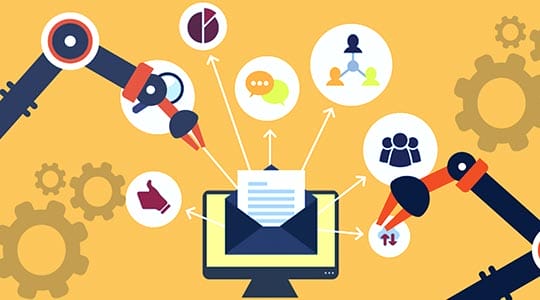To function to its full potential a business has to automate its processes, whether they relate to the sales cycle, social media, marketing campaigns, email marketing, customer interactions, services, internal communication, or any other aspect of the business. But before jumping into automation, it has to identify business areas where it can implement automation processes. There are so many areas and so many ways of automating business processes. There are some tips too, that businesses can take advantage of, in building an automation process. Here are some guides and pointers into what they can do to automate their processes.
Signs that a business need automation

Businesses can look at their systems and resources to see if they need automation. But there are some signs that they might have overlooked, and which suggest that businesses need automation in the first place. The most evident signs are:
- Improper data and random data. Data is not gathered and there is not enough data so that you can build an email list.
- Leads are not materializing into sales. Chances are that there are too many loopholes through which leads are trickling through and they do not turn into active customers.
- The sales cycle is too long, and there is a long sales process that needs to be looked at. It is taking longer for sales to get through, and it is a drain on the resources of the business, whether manual or systems.
- Poor marketing campaigns that are not based on analytics and have poor strategies.
Recommended for you: Inventive Automation in the Healthcare Industry – Tech Tools to Invest in Healthcare Startups.
Benefits of using automation for your business

Automating processes has its fair share of advantages too. Businesses can improve on these advantages and incorporate the valuable resources to bring stability into their processes and streamline their automation so that it is a sustained effort and not a one-off thing.
- Improves productivity.
- Saves time.
- Reduces marketing costs.
- Gain insight into customer behavior, insight into purchasing patterns, customer analytics, and reporting.
- Personalizes customer experience.
- Opens regular and active communication channels with customers.
- Better marketing campaigns.
- Increase inactive subscribers.
- Opens new revenue streams.
- By acquiring and retaining customers, you create a larger customer base.
Tips into growing business using automation

There are a few tips and some worthy ideas that businesses can look into when automating their processes. These are given below.
1. Use chatbots for customer service

Customers are key in turning leads into sales and they are the force that will drive the profits. Customers need to be handled 24/7. Businesses can’t decide when they will require help with operating a gadget or finding the nearest local store. At such times, it makes total sense to have chatbots, who can address each customer query. Chatbots negate the requirement of a person behind the desk, and all queries are handled by the chatbots who are programmed to give precise solutions and handle customer queries daily. Chatbots are the right automation that any business can invest in so that they do not lose customers. Nike, for example, uses its StyleBot to have a personal experience in finding the shoes of their choice. Whole Foods uses its e-commerce chatbot which lets uses find local stores, or find a recipe, and also guides them on how to make them.
2. Personalized landing pages

There are ways to interact and connect with customers and creating appealing landing pages is one of them. Landing pages can be automated to show personalized content based on consumer preferences and demographic data. Businesses can target consumers on specific products based on what their buying preferences are. Landing pages can be created using marketing automation software. For example, a business can create marketing content for landing pages for consumers who give preference to buying trekking shoes. Content for landing pages can then be written for such consumers in mind. It is the power of landing pages that attract consumers into further exploring the offerings of that business. By automating landing pages, you can automate processes like landing page features, email delivery, organizing contacts.
3. Target consumers with abandoned cart emails and automation

There may be many reasons why consumers abandon their carts. That is, they do not complete a purchase and leave it midway. The most obvious reasons for such behavior are a poor internet connection, absence of specific payment options. Such consumers drain away a huge amount of profits, and businesses can target such consumers with targeted email using automation software.
Businesses can use a strategy that allows them to send regular emails at specific intervals, to remind consumers of their empty shopping carts. Such emails can be sent using automation software and remind shoppers to pick up their purchase where they left, or even suggest better product options to them. Businesses can use automation software to speed up this process and track consumers who can be targeted. When deciding on an automation tool, every business has to consider the technical specifications involved in testing their systems. Such expertise is often provided by test automation tools that require no coding language.

4. Dynamic content to engage readers

Businesses can use specialized automation software to create dynamic content. When content is dynamic, it engages customers by showcasing products that are based on their browsing preferences and purchasing patterns. It is essential because by showing irrelevant products, which are not to the liking of customers, customers can just leave your eCommerce platform and go shopping somewhere else. By automation of content, customers are attracted, and it decreases the bounce rates and creates personalized experiences. The next time when customers log in to their preferred shopping website, it will show them products that are based on their search history and even suggest them products based on their browsing pattern. This is what dynamic content does. It personalizes messaging and improves conversation rate leading to high engagement.
You may like: How to Web Design with Better Prototyping Tools that can Automate the Process for Designers?
5. Automating social monitoring tool

Interactions on social media are a thing that businesses can track. This is vital, as customers are more active on social media, and some discussions give greater insight into the preferences of customers. It gives them an idea of how customers see the products, and what they expect of the business product offering. Social listening tools give businesses an edge and the automation that is needed to monitor social interactions on social media channels. Some are built to give a detailed analysis of data that is gathered so that businesses can then formulate marketing strategies, develop products, mold them with the required processes so that they function as the customer wants them to.
6. Segmentation of leads and increasing sales

Businesses can use automation software to send personalized emails to different segments of subscribers. So, if there is an email message that is targeted to subscriber class A, and there is a different email that is made to be sent to subscriber class B, then businesses, can automate this process to make sure that the correct email is sent to the appropriate subscriber list.
Before using this software, businesses have to manually make a list of all subscribers that fall into different segments. Businesses can use segmentation to improve their target rate, and it also improves CTR rates and minimizes bounce rates. Tags, custom fields, lists, can be specified and the automation software even suggests tags of its own, so that businesses can incorporate them into building different segments of subscribers. By segmenting subscribers, businesses can channel emails to a particular segment, and prevent it from reaching other segments, for whom, a different email is made.

7. Targeted email campaigns

Often when resorting to automation software for business processes, it happens that the automation software may become inactive for some days and is not in use. If it remains inactive for too long, it may become stagnant.
Businesses have to be proactive and keep regularly updated on how long it has not used the email automation software. If that is the case, then it also means that no email reaches the customers, and it means that customers lose interest in your product. Businesses can then set an email automation process that sends an email with renewed benefits or reduced subscription rates or offers a discount on their products. Maybe it means that a business has to review its content and design it with a strong and compelling subject line. It may also offer new products at subsidized rates and offer coupons for its established customers. It is a way of retaining the existing customers.
8. Incorporating AI into its processes

Artificial Intelligence is making rapid inroads into every aspect of this world, and businesses can also take advantage of this emerging technology. AI is what keeps businesses at the very forefront and automates their tasks that may be redundant and time-consuming. It can use Machine Learning, Object Character Recognition, Natural Language Processing, RPA to build better services and realign its products to satisfy the diversifying needs of the modern world. By using these AI technologies businesses can expect better ROI, increased sales, a broader customer base, and eventually loyal customers.
9. Reduce manual labor

Manual labor means more persons to whom to make payments and putting up with more time to finish tasks. Such manual labor is a big drain on the resources and also prone to errors and mistakes, which may turn into big faults. By reducing manual labor and investing in automation software businesses can bring more productivity and finish their tasks faster. Such businesses will eventually profit more and find more time to concentrate their efforts on building a more stable base of operations and bring efficient business models into practice.
10. More analytics and reporting

Marketing automation tools bring out more than just automating daily tasks. It has built-in analytics tools that let businesses gather customer data and analyze it to give you a systematic analysis of their behavior and buying patterns. This automation powers businesses into perceiving buying habits of customers, their demographic details, so that they can target these customers later on in their marketing campaigns. Details customer analytics and reporting is the base that gives businesses control over their products. It helps businesses to create more meaningful marketing content and present their products in unique ways. It sets a system of further automating newsletters and emails and also generates more eCommerce product lines.
You may also like: 10 Excellent Ideas to Automate Tasks in Your Small Business.
To wrap it up

These are just some tips for automation that businesses can look into. Apart from the above, there are others which also need to be seen. But it is not a sudden process to bring about automating business. It requires detailed and carefully thought-out plans and insight into where to bring automation. As such, the more automation you bring to your business, the greater time you will have to attend to other areas of business.





